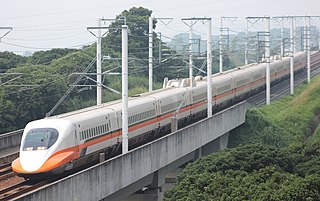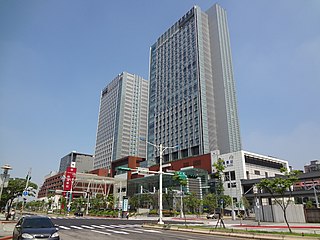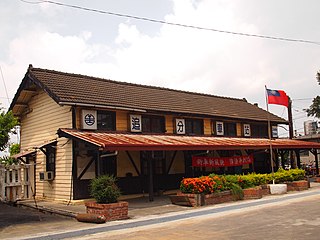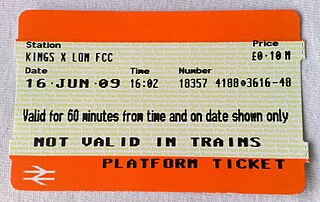Related Research Articles

Taiwan High Speed Rail (THSR) is the high-speed railway of Taiwan consisting of one line that runs approximately 350 km (220 mi) along the west coast, from the capital Taipei to the southern city of Kaohsiung. With construction and operations managed by a private company, Taiwan High Speed Rail Corporation, which also operates the line, the total cost of the project was NT$513.3 billion in 1998. At the time it was built, this was one of the world's largest privately funded rail construction schemes. The system is based primarily on Japan's Shinkansen.

Taiwan Railways Administration (TRA) is a railway operator in Taiwan. It is an agency of the Ministry of Transportation and Communications, responsible for managing, maintaining, and running conventional passenger and freight railway services on 1097 km of track in Taiwan.

Rail transport in Taiwan consists of 2,025 kilometres (1,258 mi) of railway networks. Though no longer as dominant as it once was, rail transport is an extremely important form of transportation in Taiwan due to high population density, especially along the densely populated western corridor. In 2016, over 1.09 billion passengers traveled by rail in Taiwan, averaging 2.99 million passengers per day.

Taipei Main Station is a railway and metro station in Taipei, Taiwan. It is served by Taiwan High Speed Rail, the Taiwan Railways Administration, and the Taipei Metro. It is also connected through underground passageways to the terminal station of Taoyuan Airport MRT and the Taipei Bus Station. In 2017, it was the busiest station on all three rail systems, with a total of 190 million entries and exits.

Alishan Forest Railway is an 86 km network of 2 ft 6 in narrow gauge railways running up to and throughout the popular mountain resort of Alishan in Chiayi County, Taiwan. The railway, originally constructed for logging, has become a tourist attraction with its unique Z-shaped switchbacks, and over 50 tunnels and 77 wooden bridges. Taiwan's Ministry of Culture has listed the forest railway as a potential World Heritage Site.

Nangang is a railway and metro station in Taipei, Taiwan served by Taiwan High Speed Rail, Taiwan Railways Administration and Taipei Metro. The station is served by the fastest HSR express services of the 1 series.
A rail pass is a pass that covers the cost of train travel in a certain designated area or areas within a certain period of time. It is contrasted to a point-to-point ticket in that it allows the holder unlimited travel, within the pre-designated area and period, while a point-to-point ticket only permits the holder to travel from a point to another once. It is different from a season ticket in the sense that, while both of them grant unlimited travel to the holder, season tickets normally target commuting travellers, whereas rail passes usually target tourists. Based on this difference, terms of use are thus normally set differently.

Zhuifen is a railway station on the Taiwan Railways Administration West Coast linelocated in Dadu District, Taichung, Taiwan.
The Tze-Chiang Express, also spelled "Tzu-chiang" or "Ziqiang" is a type of express train service operated by the Taiwan Railways Administration (TRA) in Taiwan. Of the five service classes operated by the TRA, the Tze-Chiang trains is the fastest category. Ticketing is done on the basis of mileage. This service is operated with 7 different trainsets: the E1000 series, the EMU1200, EMU300, TEMU1000, DR2800, DR3100, and the TEMU2000. The now-retired EMU100 was the first trainset built for this service, which was used for 30 years, terminating ordinary runs at June 15, 2009.

A platform ticket is a type of rail ticket issued by some railway systems, permitting the bearer to access the platforms of a railway station, but to board and use any train services may become fare evasion. It allows people to walk with their friends, associates and loved ones all the way to the passenger car at stations where the general public is not admitted to platforms. Trainspotters can also purchase platform tickets and enjoy their trainspotting hobbies. They vary in type: some may only allow limited access and a sharply limited time of usage, while others may have totally free access to enter the platform area. During peak usage hours or rush hours, the platforms may only be available for passengers who intend to travel.

Keelung Station is a railway station in Ren'ai District, Keelung, Taiwan served by Taiwan Railways. The station was built in 1891, and has gone through several renovations.

Banqiao is a railway and metro station in New Taipei, Taiwan served by Taiwan High Speed Rail, TRA and Taipei Metro. With the exception of the Circular Line, all other tracks and platforms in the station are located underground. The station is served by the fastest HSR express services of the 1 series.

The Shalun Line is a branch line of the Taiwan Railways Administration (TRA) West Coast line in Tainan, Taiwan. It was built to link the Western Line to the Taiwan High Speed Rail (THSR) Tainan Station, speeding up transit times between downtown Tainan and the THSR station, with services running from Nanke railway station or Tainan TRA station to Shalun Station, next to the THSR station. The line opened on January 2, 2011.

Yingge is a railway station in New Taipei, Taiwan served by Taiwan Railways.

Fuzhou is a railway station on the Taiwan Railways Administration West Coast line located in Banqiao District, New Taipei, Taiwan.

Taiwan Railway Bento are a type of ekiben manufactured and distributed by the Taiwan Railways Administration at major railway stations and in train cars. It is estimated that, with five million boxed meals sold per annum, the annual revenue from bento distribution is 370 million NTD.

South Shulin is a station on the Taiwan Railways Administration West Coast line located in Shulin District, New Taipei, Taiwan. South Shulin Station is located at the intersection of Zhongshan Road and Dongxing Street.

Fugui railway station is a railway station located in Hengshan, Hsinchu County, Taiwan. It is located on the Neiwan line and is operated by the Taiwan Railways Administration.

Auspicious train tickets refer to train tickets with auspicious messages on them derived from the beginning and end stations on the ticket. Messages often employ homophonic puns in both Mandarin and Hokkien and shuffling the order of characters to reach the desired effect. In Taiwan, the Edmondson tickets are sought by collectors and people wishing for good luck.

The Donggang line was a railway line of the Taiwan Railways Administration that ceased operations in July 2002. The line was a branch line of the Pingtung Line, diverging at Zhen'an Station to the coastal town of Donggang. The route ran parallel to the current-day Provincial Highway 17.
References
- ↑ There is no official Chinese name for the pass, but some Chinese travelers do refer to it as "台灣鐵路周遊券". See the section "Name" for more details.
- ↑ News Announcement
- ↑ A Press Release from TRA at 12 June 2009
- ↑ Timetable of Development of TRA Archived 21 September 2013 at the Wayback Machine
- ↑ TRA explanation of the Round-the-Island Pass Archived 20 October 2013 at the Wayback Machine
- 1 2 3 News article about issuing the new General TR Pass, replacing the old Round-the-Island Pass
- 1 2 3 4 5 6 7 8 9 10 Official website
- 1 2 3 4 5 TRA Info
- ↑ It was previously run by a private company, but Council of Agriculture's (COA) transferred the operation to TRA in 2013. However, TR Pass is still unusable in this line.